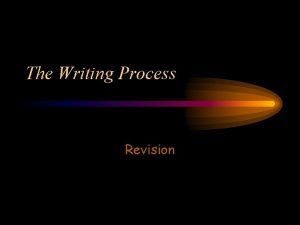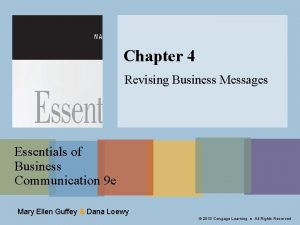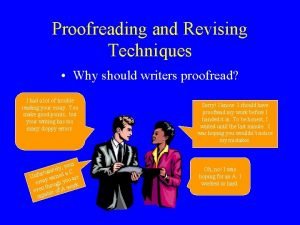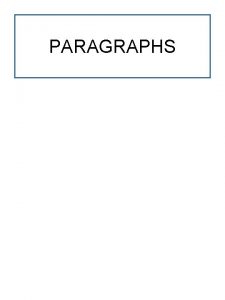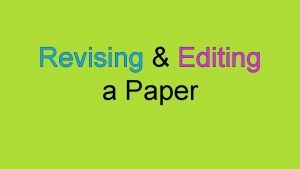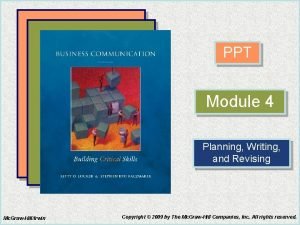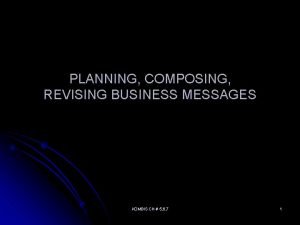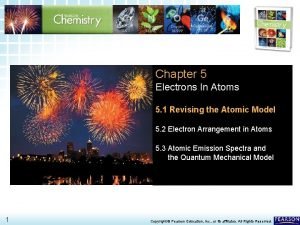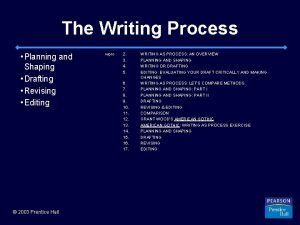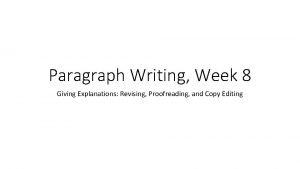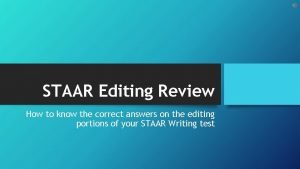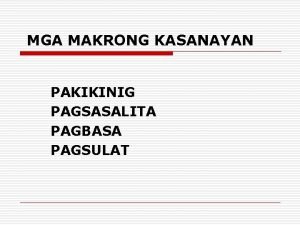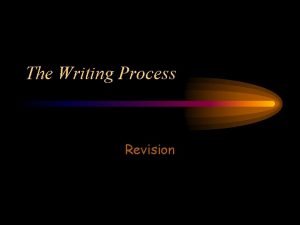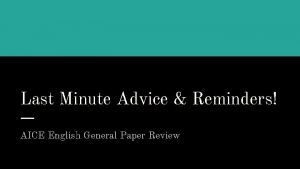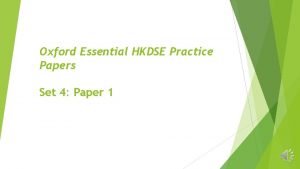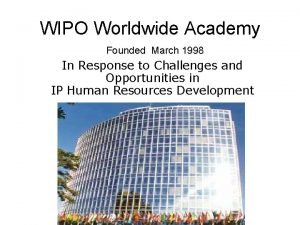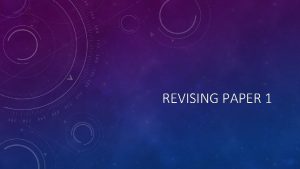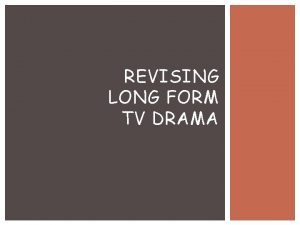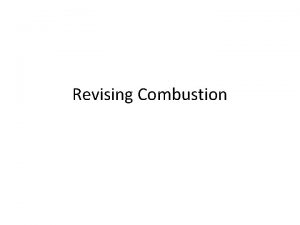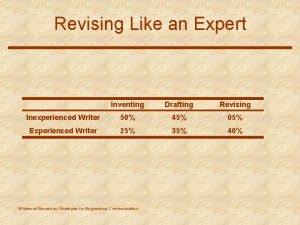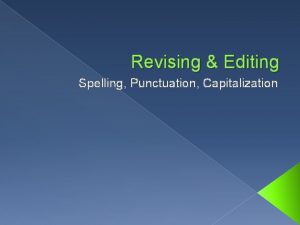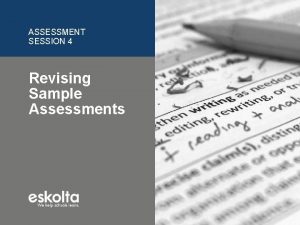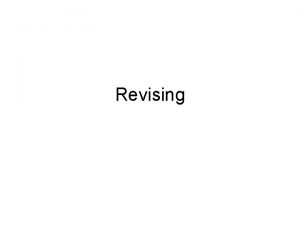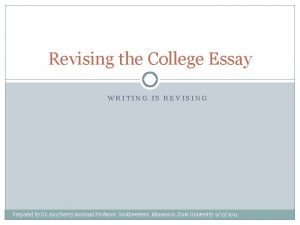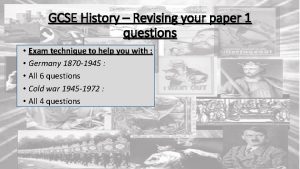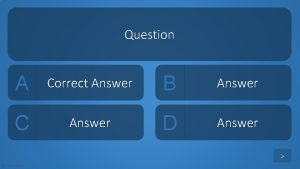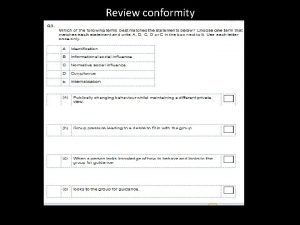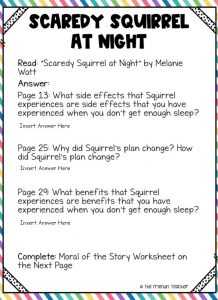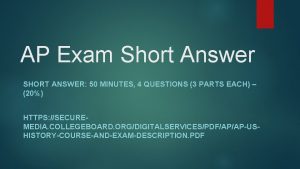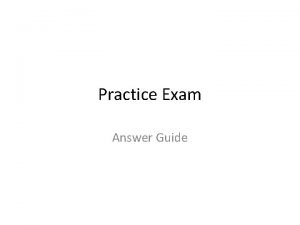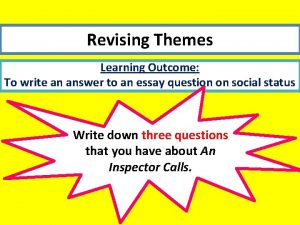REVISING PAPER 2 THE EXAM answer Paper 1






















- Slides: 22

REVISING PAPER 2

THE EXAM -answer Paper 1 (70 marks) all questions Paper 2 (70 marks) Section A (4 Questions) Section A (2 questions) • News (and news websites but this will nit be directly in the mock – you can refer to them) Media Industries There will also be a question on theory Section B (2 questions) • Advertising (Unseen analysis) • Music video (Set texts) • Film Industry -Jungle Book(s) • Radio – BBC Section B (2 questions) Long Form TV Drama There will also be a question on theory

MARKS AND TIMINGS FOR PAPER 2 (2 HOURS) Marks Timing Question 1 15 25 mins Question 2 15 25 mins Question 3 30 55 mins Question 4 10 15 mins Section A Section B (120 mins)

FORMAT OF QUESTIONS The questions might ask you to do 1 of 3 things (question 3 asks for all 3 ! As well as all 5 contexts) • Analyse – examine (something) methodically and in detail, typically in order to explain and interpret it • Explain – make something clear by describing it in detail • Make judgements (evaluate)

THE EXAM – PAPER 2 The four questions will be as follows: Q 1 15 marks This question will ask you to explain features of a media industry you have studied. You could be asked to explain how some contexts have influenced the making of the product. You will be expected to answer from a factual basis. You will have 25 minutes to plan and write your answer. Q 2 15 marks This question is the same as Q 1, you have to explain features of a media industry you have studied. You could be asked to explain how some contexts have influenced the making of the product. You will be expected to answer from a factual basis. You will have 25 minutes to plan and write your answer. Q 3 30 marks This will be a complex question including a number of bullet points asking you to: ● Show knowledge and understanding of theoretical framework as it applies to long form TV drama, especially around the making of the drama and audience appeal ● Analyse your chosen examples from the set text, especially in terms of media language and representations Make judgements and draw conclusions. ● This extended essay should take about 50 minutes to plan and write – it is the longest essay across both papers Q 4 10 marks This question asks you to evaluate an academic theory in relation to long form TV dramahow useful is it in understanding the programme you have studied? You will be given a choice between two theories. This short essay should take about 15 minutes to plan and write.

THE OCR WEBSITE ● ● Go to the OCR Media Studies Website Look at the Planning and Teaching Section In the Teacher Guides sub section there are Guides for Jungle Boos and Radio 1 – although this is for the Breakfast Show (with Nick Grimshaw !!!!) There also exemplar answers in the Assessment section – but be warned, these were written by Principal Examiners with unlimited time

SECTION A - QUESTIONS 1 AND 2 By the time you come to the real exam you will have studied 3 media industries: 1. The Film Industry 2. Radio 3. Video Games Industry The exam will ask about 2 of these 3 (your mock exam will be about Radio). Film & The essays must contain facts, not just opinions. So learning about technology, budgets, audience figures/box office/sales and using the correct Terminology is important

CONTEXTS • Questions 1, 2 and 3 can also ask about context • Jungle Book – Economic and historical (budget/box office AND films from different eras/internet) • Radio – Economic, political and cultural (funding (PSB), remit and young people ‘listening’ to radio) • You should cover the above contexts ‘naturally’ in your answer whatever the question • Deutschland 83 (Long Form TV Drama) – Historical (setting), political (Communism/anti government), economic (production detail), social/cultural (women, consumerism, streaming) cultural (German language TV Drama –successful abroad)

JUNGLE BOOK(S) REVISION How much can you remember ? Let’s start with the Film Chain – do you know what this is? Production, Distribution and Exhibition/Exchange What is it called when Production, Distribution and Exhibition/Exchange are combined ? Vertical Integration Are either Jungle Books an example of this ? Yes – both are Why is vertical integration supposedly ‘banned’ in the USA ? Because it gives a single company too much control Now let’s do a Kahoot !! – use the pin number and start !

JUNGLE BOOKS REVISION 1. 2. 3. 4. 5. 6. 7. 8. What was the technological innovation for JB 67? What was the technological innovation for JB 16? What was the release pattern for JB 67 ? What was the release pattern for JB 16 ? In what media forms was JB 67 advertised ? How was JB 16 advertised ? Name the social media that JB 16 used – try and be specific What advantages did social media offer JB 16 over the traditional way that JB 67 had to be advertised ?

RADIO 1 REVISION (1) 1. What does PSB stand for ? 2. What are the 3 things that PSB is meant to do ? 3. Who came up with the idea ? 4. IN what way is PSB limiting for Radio 1 ? 5. In what ways is PSB supportive for Radio 1 ? 6. What is the budget for Radio 1 (in 2017) ? 7. Who gives this money ? 8. What potential problems are there in this arrangement ? 9. What is the Radio 1 remit ? 10. What sort of things should be broadcast by Radio 1 ? 11. Does this offer commercial radio any advantages ? 12. How much news should there be on Radio 1 ?

RADIO 1 REVISION (1) 1. What is the target audience for Radio 1 ? 2. Are young people are listening to Radio 1 ? 3. How do young people ‘listen’ to Radio – what is the new threat to Radio 1 ? 4. Name 5 ways Radio 1 attempts to reach a young audience Presenters – topics – website – social media - youtube

THE EXAM – SECTION B LONG FORM TV DRAMA The two questions will be as follows: Q 3 30 marks This questions asks for an extended essay. You will be expected to: • Analyse scenes (of your choice) from episode 1 of Deutschland 83 explaining the media language and representation (and possible appeal to audience). • Explain the different contexts that are involved in episode 1 of Deutschland 83 • Make judgments in response to the question A top band answer would also be expected to have some reference to theory (genre, narrative, representation, even audience) Q 4 10 marks This question asks you to evaluate an academic theory in relation to long form TV Dramahow useful is it in understanding the genre? You will be given a choice between two theories. This short essay should take about 15 minutes to plan and write. In the ‘real’ exam, you will have to write about an English Language Long Form TV Drama (Stranger Things)

DON’T FORGET CONTEXTS For Deutschland 83, what is your specific example of: • Historical context • Political context • Economic context • Social Context • Cultural context Long Form TV Drama question also requires you to look at all 4 areas of the media framework – media language (genre, narrative), representation, Institution (production, budgets, exhibition) and audiences (German and non-German) Very similar to contexts !

GENRE OF DEUTSCHLAND 83? • Spy ? • Historical ? • Political ? • Coming of Age ? (Bildingsroman ? ) • Hybrid (the same – but different – whose theory is that )

OTHER MEDIA THEORISTS THAT COULD BE APPLIED • Barthes – key signifiers and furthering of myth about East Germany • Todorov – narrative equilibrium and disruption • Levi-Strauss – obvious binary opposites between East and West • Van Zoonen – representation of women in a patriarchal society • Gilroy – only black character is a non-German (an American general – sense of otherness – not a great example as we only meet him briefly in episode 1 ) • Hall – different reading from different audiences – Germans didn’t like it, felt characters were too stereotypical.

WE ARE GOING TO LOOK AT 3 DIFFERENT SIGNIFICANT SCENES NEAR THE START OF EPISODE 1 • For each scene have a little chart like this: Feature Notes Camera shots Mise-en-scene Sound (music) Lighting Representation of Martin/Moritz Representation of others in scene • Can you guess what audience each scene is attempting to appeal to and how do you know this?

THE SCENES Scene 1 A party for Martin’s mother – Martin turns up unexpectedly Scene 2 Martin is recruited by the Stasi Scene 3 Martin/Moritz attempts to break free in capitalist West Germany and ends up in a supermarket full of goods

How to write a Long Form TV Drama essay - IDEAL Intro Define the representations/media language you are going to look at in response to the question. Para 1 Industry information about Deutschland 83 (Economic context) The older fashioned production process and its advantages. Relate back to question Para 2 Budgets and their effects on filming and production. (Cultural context) Discuss cinematography, editing , sound and mise-en-scene in general. Relate back to question Para 3 Narrative and Genre – D 83 (Political/ historical context) How does the story effect the viewer and position the audience? Relate to question Para 4 Representation/Media language 1 – (could/should do gender). Add theory – Van Zoonen (gender is performative)or Neale and discussion of genre. Relate to question. (Social context, possibly cultural context as well) Para 5 Representation/ Media Language 2 – (could/should do gender). Could add more theory – look at audience and Hall. (different readings – preferred what producers want). Relate back to question

QUESTION 4: EVALUATE A THEORY In this question, you will be asked to evaluate the usefulness of one of two theories, in relation to your set products (Deutschland 83 in this case ). You won’t know until you sit the exam which of theories could come up. Ensure you knowas many as you can, if not all of them! However the question should help. You don’t need to explain theory in any detail, but you do need to evaluate it and how far it might help youanalyse TV long form drama.

SAMPLE QUESTIONS 4. Evaluate the usefulness of one of the following in helping your understanding of Deutschland 83: EITHER Van Zoonen’s theory of gender and patriarchy OR Levi-Strauss theory of structuralism [10]

SUGGESTED STRUCTURE AND FRAME ● ● ● Outline theory- 2 sentences IF YOU DON’T THINK THEORY IS USEFUL, SAY WHY AND THEN GIVE ANOTHER THEORY FROM THE SAME FRAMEWORK GROUP THAT IS. THIS IS NOW THE ‘THEORY’ THAT PLAN REFERS TO. Give an example from Deutschland 83 that supports theory mentioned in the question. Explain example in detail and how it supports theory. Give another example from Deutschland 83 that supports theory mentioned in the question. Explain example in detail and how it supports theory. Give a final example from Deutschland 83 that supports theory mentioned in the question. Explain example in detail and how it supports theory. Conclusion. Sum up by evaluating theory again
 What is revising
What is revising Kaisahan sa pagsulat
Kaisahan sa pagsulat Revising and proofreading business messages
Revising and proofreading business messages Proofreading and revising
Proofreading and revising Revising paragraph
Revising paragraph Editing vs revising
Editing vs revising Revising and editing ppt
Revising and editing ppt Planning business messages adalah
Planning business messages adalah Revising the atomic model
Revising the atomic model Planning drafting revising editing
Planning drafting revising editing Paragraph proofreading
Paragraph proofreading Unity in a paragraph means
Unity in a paragraph means Staar revising and editing
Staar revising and editing Ito ay parang pakikipagdebate nang pagsulat
Ito ay parang pakikipagdebate nang pagsulat Similarities of editing and revising
Similarities of editing and revising What is revision?
What is revision? Aice general paper final exam
Aice general paper final exam Hrm question paper
Hrm question paper What is aice general paper
What is aice general paper Aice general paper hand approach
Aice general paper hand approach Oxford essential hkdse practice papers answer key
Oxford essential hkdse practice papers answer key Pept test meaning
Pept test meaning Wipo dl-101 final exam questions
Wipo dl-101 final exam questions
